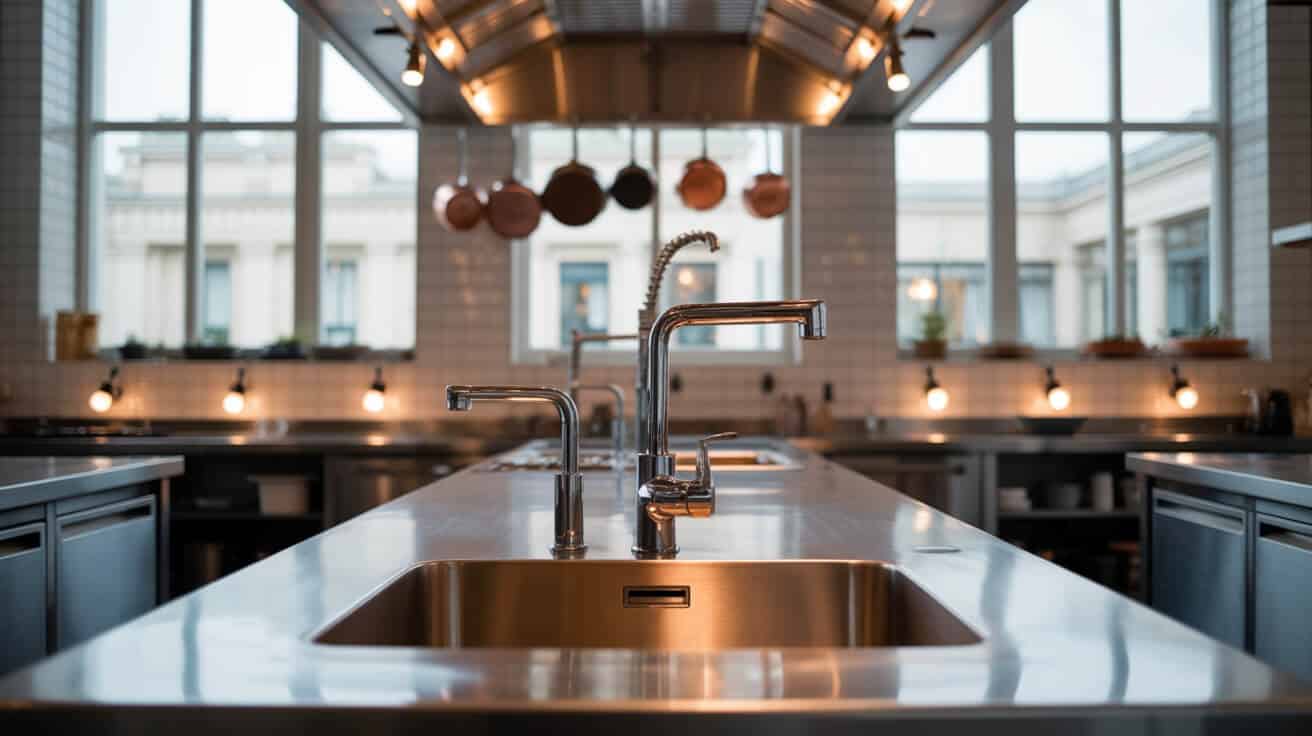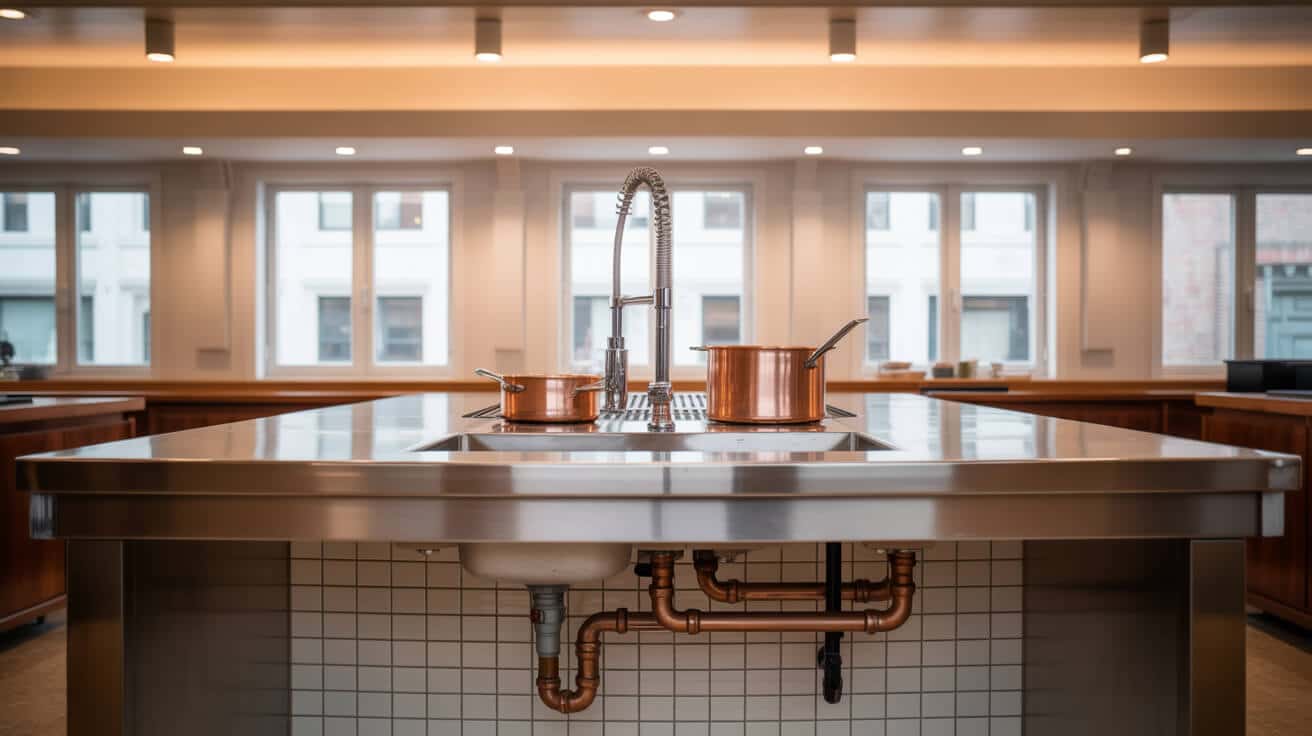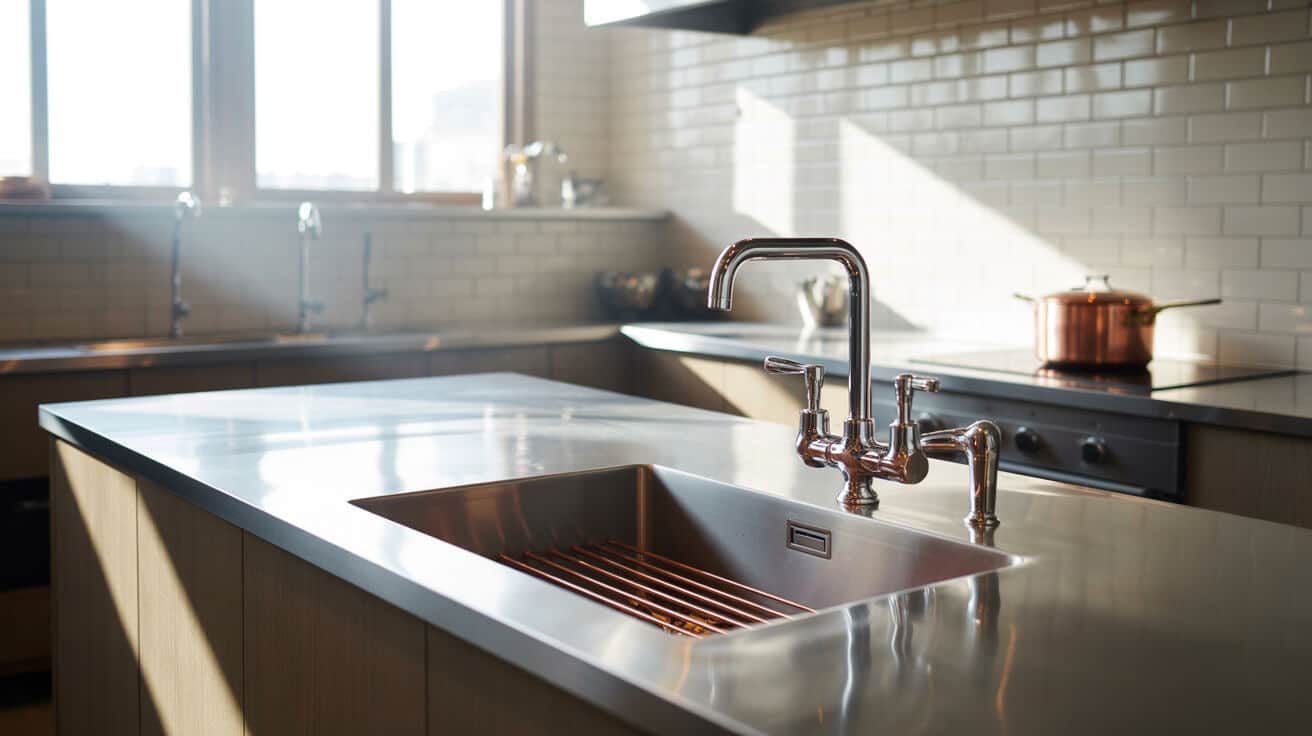The plumbing infrastructure in restaurants sits at a complex intersection of regulatory demands, public health, and business resilience. System design responds dynamically to unpredictable traffic, high-volume waste output, and strict hygiene standards, forming a backbone for your company’s operational continuity and customer experience. Multifunctional spaces—ranging from kitchen prep zones to accessible patron bathrooms—must undergo careful planning, robust installation, and ongoing management to anticipate and mitigate both everyday disruptions and high-stakes breakdowns that threaten your reputation and revenue.
Etymology or name origin
“Plumbing” derives from the Latin plumbum, the word for lead, reflecting the use of lead in historical piping systems. In the hospitality sector, the language of plumbing has evolved to address technological and regulatory shifts: grease trap identifies devices that intercept fat, oils, and grease; backflow preventer became widely used as potable water safety regulation tightened; and commercial plumbing is now referenced as a specialised subset within building services, denoting installations serving shared, high-turnover, and regulated spaces. Contemporary vocabulary increasingly blends engineering terminology with regulatory and food hygiene concepts.
Overview / context
Restaurant plumbing is characterised by extensive, strategically routed networks of water supply and drainage piping, supported by centralised and point-of-use heating, filtration, and waste interception infrastructure. These systems must manage unpredictable load profiles—lunch and dinner peaks, event surges, or supplies interruptions—and enforce line-of-sight compliance with local authority and national health and safety regulations.
Commercial and residential distinctions
Commercial-grade installations employ higher-diameter pipes, schedule 40+ materials, and industrial drain interceptors. Unlike domestic environments, your company faces mandatory requirements for grease management, redundant protection against cross-contamination, and continuous water temperature monitoring. Redundancy in supply and rapid maintenance access is engineered to reduce downtime during faults, while frequent turnover in staff and high throughput of fixtures (taps, dishwashers, ice machines) demand robust, user-friendly operability.
Role in restaurant operations
Plumbing underpins every stage of service, from raw ingredient washing to dish replenishment and staff personal hygiene routines. Operations depend upon system reliability for both cost control and local authority passage. Strategic layout and future-proofing design are central in minimising risks of compliance breaches, foodborne illness, or environmental incidents that may originate from an overlooked valve or clogged trap.
Health, hygiene, and compliance context
Compliance is codified by overlapping legal and safety regimes, including WRAS approval, United Kingdom Water Regulations 1999, and the Food Standards Agency. Hygiene protocols require thermal disinfection capacity, separation of potable and non-potable supply, and system design that enables routine Legionella management. Plumbing deficiencies identified during regulatory inspections can result in immediate operational suspension or recurring fines.
History
Origins in public eating houses
Early catering spaces integrated basic sanitation via nearby wells, barrels, or gravity drains. By the mid-1800s, densifying urban environments and growing public dining trends necessitated indoor sinks and pipework, with restaurants adopting early forms of sewage and hot water infrastructure that paralleled the rise of municipal utilities.
Industrialization and kitchen technology
Emerging mass catering operations, especially hotels and canteens, accelerated the adoption of mechanical dishwashers, vented drainage, and centralised water heating. Regulatory codes emerged in the early twentieth century to enforce separation of food and waste flows, the introduction of grease traps, and the foundational elements of staff hygiene management within plumbing design.
Modern compliance and building regulations
By the late twentieth century, statutory requirements had extended to all aspects of commercial plumbing: anti-scald mixing valves, automatic shutoff devices, auditable backflow prevention assemblies, and detailed asset management for both fixtures and waste management. Modern codes prescribe not only the use of WRAS-approved fittings but also regular calibration, maintenance, and documentation to assure ongoing compliance.
Sustainability and digital monitoring
From the early 2000s, industry-wide shifts toward sustainability saw energy-efficient boilers, low-flow fixtures, and water recycling mechanisms introduced as standard practice. Digital metering, leak-sensor networks, and predictive maintenance models emerged in response to rising energy costs and the regulatory imperative for conservation. Smart integration increasingly enables both kitchen managers and your company’s facilities staff to preempt failures and optimise compliance.

Principles and core concepts
Water supply and hot water systems
Restaurants employ a layered network of supply pipes, isolation valves, booster pumps, and water heaters. Hot water demand is forecasted based on kitchen output, staff numbers, and compliance with handwashing and sanitation codes. Safety-critical temperature limits are enforced for both pathogen control and anti-scald protection, sometimes through thermostatic mixing valves and digitally controlled heaters.
Wastewater and drainage
Wastewater management requires solid-laden and fat-laden streams to be efficiently conveyed to municipal or private sewer systems. Kitchen drains are routed for steeper gradients and greater diameters than in domestic installations, discouraging sediment buildup. Floor drains, trench gullies, and indirect waste in ice machine and blender stations provide further capture points for runoff, while air gaps and venting mitigate odours and negative pressure incidents.
Grease management
Interceptors, separators, and dosing systems address FOG waste at both the appliance and line level. Sizing calculations weigh menu profiles, sink usage, and dish volume. Scheduled removal and compliance logging are required by local authorities, reducing risk of blockages, enforcement action, and system downtime. Increasingly, your maintenance provider may offer sensor-equipped, service-monitored equipment to optimise collection intervals.
Backflow and cross-connection prevention
Potable water is safeguarded via RPZ (reduced pressure zone) valves, testable double checks, and air gaps. Any cross-connection—instances where contaminated waste can enter feeds for prep sinks, beverage stations, or appliances—invalidates authority compliance and increases health risks. zoning, labelling, and periodic retesting are routine, especially as kitchens reconfigure over time.
Heat and energy efficiency
hot water systems target optimal delivery temperatures between 60°C and 65°C for hygiene, balancing risk of microbial growth and scald incidents. Modern systems may incorporate energy recovery from greywater or heat exchangers as part of decarbonization strategies. Pipe insulation, logical zoning, and temperature-activated recirculation loops further reduce wastage and cost.
Functional zones and applications
Kitchen and food preparation
Each wash sink, chef station, and prep area is individually plumbed for cross-connection protection, reliable pressure, and hand hygiene accessibility. High-turnover equipment—combi-ovens, pre-rinse sprayers, vegetable washers—interface directly with plumbing manifolds calibrated for sustained and simultaneous use during peak service.
Dishwashing and warewashing
Commercial dish and glasswashers require high-flow hot supply, pressure regulation, and rapid drainage. Traps and catch basins are co-located to minimise backflows and overflows. Ongoing maintenance of these zones, including the disassembly and cleaning of strainers, directly impacts operational hygiene and compliance.
Bar, beverage, and coffee
Bar plumbing distributes filtered and, in some cases, softened water to ice machines, soda guns, and espresso makers. These lines experience recurrent temperature swings and standing water risks; their maintenance is vital in preventing taste, odour, or microbial issues in served beverages.
Sanitary facilities
Staff and guest lavatories are equipped with flush valves and touchless, temperature-regulated taps, often integrating sensor activation for hygiene. Multiple occupancy increases pollutant load and maintenance frequency. Doc M compliance ensures accessibility and protection against Legionella exposure.
Janitorial and utility spaces
Janitor sinks, chemical dispensers, and mop refill stations are segregated by colour-coding and anti-backflow valves. Isolated drainage ports and wall-mounted hose bibs foster both routine cleaning and rapid intervention during spills or contamination events.
Plant rooms and mechanical
Boiler plants, expansion tanks, and water storage reside in code-segregated utility rooms with designated inspection paths. Monitoring systems—thermometers, pressure gauges, digital flow metres—enable both predictive maintenance and on-demand troubleshooting.
Key system components
Pipe materials and sizing
Pipe material choices are informed by chemistry of influent and effluent, usage cycle, and regulatory guidance. Stainless steel and MDPE are preferred for resistance to corrosion, thermal stress, and ease of cleaning. Sizing tables project maximum anticipated flow and waste loads, ensuring consistent performance under service peak demand.
Grease traps and interceptors
Options include passive, mechanical, and electronic dosing grease management. Interceptor efficiency is validated by periodic observation, and failures are reported as scheduled, both for your risk management and local compliance.
Water heaters and boilers
Central or distributed, water heaters are selected for capacity according to the Business and Domestic Water Usage Model—a composite calculation accounting for fixture type, seating capacity, and anticipated peak usage. Redundancy is incorporated for critical compliance in food prep and sanitation.
Water filtration and softening
Filtration units, from carbon block to reverse osmosis modules, are sited at beverage stations or point-of-use dish machines. Service intervals are contractually maintained, with logs supporting both preventive care and audit compliance.
Booster pumps and pressure regulation
Pressure-boosting assemblies preserve system function where gravity or municipal supply is insufficient, or during multiple concurrent demands (e.g., simultaneous dishwashing and restroom use).
Sensor taps and control interfaces
Electronic or foot-operated fixtures allow for both touch-free activation and user-adjustable flow, improving hygiene while reducing water use.
Backflow devices and check valves
Vendor-specified check valves and municipal code-listed RPZ devices are installed per hazard assessment, routinely tested and catalogued by your maintenance provider.
Types and classifications
Centralised versus decentralised hot water
Large establishments may prefer centralised hot water plants for economy of scale, while point-of-use devices suit modular kitchen setups, reducing dead leg lengths and improving temperature consistency. Energy and maintenance requirements define the optimal mix.
Gravity and pumped drainage
Standard gravity-fed drains are supplemented by pumped waste systems in below-grade kitchens or where high-peak demand generates localised pooling risk. Pump selection is based on anticipated waste load, vertical lift, and system redundancy.
Manual and sensor-actuated fittings
Legacy installations may retain manual fixtures, but sensor-actuated taps, flushes, and sprays are increasingly specified for their water use reduction and touch-free hygiene benefits.
Grease management technologies
Passive traps serve low-volume kitchens, while automatic and monitored interceptors are needed for high-output operations. Where operator attention is at a premium, remote-logged units facilitate hands-off compliance monitoring.
Smart plumbing and monitoring
Emergent systems use a network of flow, temperature, and pressure sensors to compile performance data and optimise maintenance routines. Integration with building management systems and mobile alerting reduces response times and loss events.

Installation and methodologies
Design and site assessment
Your company typically collaborates with a consultant and a WRAS-approved plumbing firm, balancing menu needs, local regulatory context, and space constraints. Site surveys map fixture placement, drainage topology, and isolation points.
Pipe routing and insulation
Runs are planned to avoid cross-traffic, minimise waste trap dead legs, and ensure point accessibility. All pipes are insulated per code for energy savings and microbial risk management, including the use of trace heating for vulnerable external lines.
Fixture and appliance integration
Prep sinks, dish machines, and beverage units receive separate feeds and controlled waste outfalls. Installation details specify air gap distances, waste trap locations, and appliance connection logic for both ease of maintenance and code compliance.
Commissioning and sign-off
System commissioning verifies water pressure, flow, temperature, and waste evacuation. Cross-connection tests and pressure logging, often performed by an independent inspector, precede local authority certification.
Coordination with other trades
Plumbers coordinate with gas fitters, electricians, refrigeration, and HVAC teams for optimal zone layout, workflow efficiency, and equipment access, all under the supervision of your designated project or facility manager.
Maintenance, inspection, and monitoring
Preventative maintenance and PPM
Scheduled inspections target grease trap servicing, philtre replacement, backflow prevention testing, and valve operation. Preventative maintenance contracts, most often overseen by firms such as Plumbers 4U, document all actions for both asset management and audit trail.
Emergency response procedures
Contingency planning requires clearly marked shut-off points, direct communication channels, and escalation plans for severe blockages or system failures. Maintenance partners guarantee response times and stock rapid replacement parts.
Regular inspection and audits
Local authority and health inspectors reinforce compliance through routine sampling of water quality, review of equipment logbooks, and cross-examination of FOG trap maintenance records. Your ability to produce up-to-date documentation improves audit scores and protects against operational sanctions.
Smart sensors and remote monitoring
Digital monitors report deviations from set points, signal automated alarms, and enable remote adjustment, all designed to minimise asset downtime and streamline compliance.
Training and documentation
Comprehensive records support your daily, weekly, and annual maintenance activities. Staff are trained in correct reporting, shut-off protocols, and basic visual inspection of plumbing hotspots.
Stakeholders and roles
Owners and operators
Establish asset management priorities, balance risk against lifecycle costs, and direct both capital investment and strategic maintenance policy for your properties.
Facilities managers
Supervise documentation, orchestrate inspection schedules, select service vendors, and respond to operational disruptions as primary decision makers.
Health and environmental inspectors
Undertake detailed assessments of workplace and customer-facing plumbing systems, with authority over pass/fail determinations and mandated remedial action.
Technicians and contractors
Execute physical installation, perform sophisticated troubleshooting, and maintain up-to-date certifications in code compliance and safety procedures.
Enforce public health statutes and environmental standards, issue fines, and provide both consultative input and ultimate sign-off on critical infrastructure.
Kitchen designers and architects
Unify operational design with regulatory mandates and human factors engineering, integrating plumbing into a holistic restaurant development or refurbishment project.
Legal, regulatory, and ethical considerations
National and regional codes
System operation is subject to WRAS approval, UK Water Supply (Water Fittings) Regulations 1999, and building codes for drainage, water safety, and energy use. Documentation certifies ongoing operational conformity.
Food safety and hygiene law
Statutes from bodies like the FSA mandate ongoing system monitoring, water temperature management, grease control procedures, and accessible logkeeping.
Certification and record-keeping
Ongoing certification is necessary for specialist fixtures (e.g., RPZ valves, FOG interceptors), maintenance routines, and all emergency or unscheduled repairs. Auditable records confirm due diligence.
Sustainability and waste permits
Your company is responsible for effluent discharge logging, waste collection agreements with certified contractors, and compliance with local and national sustainability rules.
Duty of care
Installations and operational routines are configured for user safety, proper waste handling, and minimal environmental impact. Ethical procurement, vetting of contractors, and proactive risk controls are central in professional practice.
Performance metrics and data
Water pressure, flow, and temperature
Daily logs of water pressure and flow rates are maintained for compliance and troubleshooting. Automatic systems may generate exception reports for dips or surges.
Energy use and carbon assessment
Water heating profiles, pump energy use, and waste-system electrical consumption are logged and analysed for both operational and environmental reporting.
Drainage and blockage frequency
Incident logs track clogging frequency, backflow events, and negative performance anomalies. Data supports decision making for both replacement cycles and operational risk controls.
Grease trap service intervals
Asset monitoring determines both actual and optimal grease trap clean-out intervals, with missed service recognised as a leading indicator of future system failures.
Incident and maintenance reporting
Comprehensive records of every maintenance event, asset failure, or audit precondition provide insights for both cost modelling and compliance assurance.
Challenges, barriers, limitations
Operational or technical issues
Peak service periods, staff rotation, or conversion of space (café to full restaurant) can overload system design and schedule, causing bottlenecks and service risk. Your business continuity planning and infrastructure foresight are directly measured by system resilience under such strain.
Social and economic factors
Skill gaps and high turnover affect staff proficiency in maintenance, while cost control pressures can delay necessary upgrades or routine care. Understanding these factors enables strategic investment in your facility infrastructure.
Regulatory evolution
Legislative updates may require sudden adaptation, especially for discharge limits, grease management, and pathogen risk. Overlooking compliance can jeopardise your company’s licencing and market standing.
Frequent causes and solutions
Common incidents, including dish station flooding, persistent blockages, or repeated health citations, are most effectively addressed by systems-level, preventive interventions—supported by robust documentation and real-time monitoring.
Impact, influence, legacy
Regulatory-driven system upgrades, continuous asset management, and predictive maintenance models have redefined the hygiene, uptime, and profitability of foodservice properties. Ongoing innovation in water, waste, and heating management shapes not just operational procedure but the customer experience and competitive landscape in the restaurant sector.
Future directions, cultural relevance, and design discourse
Digitally enabled water management, greywater and rainwater harvesting, and low-carbon heating systems are shaping the future of engineering and operations in restaurant settings. As decarbonization and sustainability become cultural touchstones, your company’s plumbing architecture will increasingly reflect values beyond hygiene and compliance, encompassing climate impact, community trust, and even online reputation among eco-conscious patrons. Collaboration between property owners, service providers, and design professionals is expanding the reach of plumbing beyond functional infrastructure to a central driver of hospitality ethos and identity.

